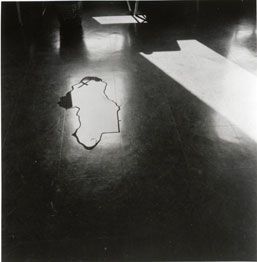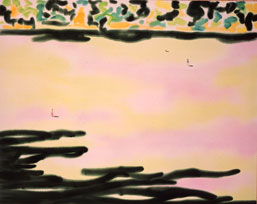Meaningful Stain
Now if I had know that my frenzy of throwing blobs of paint on every surface I saw, and haphazard spilling of any drink on the table was art, maybe my parents would have been kinder to my artistic sensibilities as a seven year old and I’d have a space in the “Meaningful Stain” exhibition. The Museum of Modern Art Tokyo’s latest offering is as mysterious as its sounds, I know that the stains are meaningful — but I’m not sure what they’re supposed to mean.
The exhibition defines a stain as “a trace on the surface of cloth, paper, walls, floors etc. made by contact with something moist.” and offers visitors a chance to explore the psyche of the stain. What happened there? When did it happen? How did the stain get there?
“Meaningful Stain” expects visitors to have an almost Holmesian interest in the origins of the stains while at the same time keeping an open mind to new forms that the stain might take. The latter is certainly needed as some pieces, such as Noboru Kitawaki’s “Decalcomania” series, takes liberties with the creation of the stain. Similarly the patterned pieces of Claude Viallat and Tatsuo Kawaguchi brings up the question if a stain is really a stain if purposefully executed? Personally, the essence of a stain lies in the utter accidental circumstances it arises from — one which lies on the edges of human control.


Naofumi Maruyama’s ‘Garden 1’ is aesthetically interesting, and with his clever use of space, the effect is hauntingly beautiful. The meaning of the stain shifts from the massive black that creeps over and around the cotton canvas, to the two tiny children playing catch-ball. It’s pieces like these that perhaps truly embody the questions the exhibition tries to raise. Building upon the same line of questioning, Shigeo Gocho’s ‘From “SELF AND OTHERS”’ seems to imply that the stain is in fact, the human subject.
Other pieces like Koji Enokura’s ‘Two Spots’ and ‘Print (STORY & MEMORY) No. 1’ are visually straightforward and attempt at inciting a story out of the visitor’s imaginations. However, like his photographs, there seems to be something lacking in the meaning of his stains. It almost reads like a rather contrived project, where the piece doesn’t hold up to the intentions behind it. It’s certainly a pity as the exhibition is centered around Enokura’s body of work.
The premise behind “Meaningful Stain” is solid, and while the pieces have their own clout individually, they don’t hold together well as an exhibition. With Enokura’s work as the main focus — even the layout of the exhibition places Enokura in the spotlight — the other pieces end up being more of a cursory addition to the exhibition, and dilutes whatever impact that Enokura’s works might have had.
Alicia Tan
Alicia Tan



